Top 7 mistakes when working with reviews in the App Store and Google Play
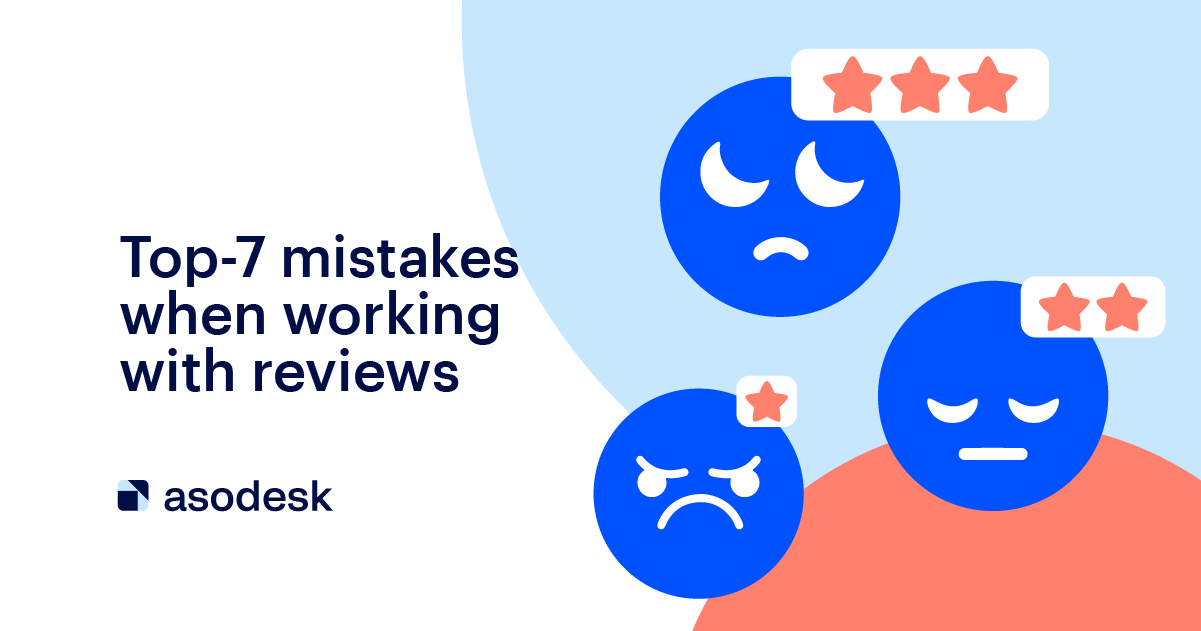
Improper work with reviews leads to a decrease in rating and number of installs, as well as a high number of uninstalls. In this article, I’ll discuss the most common mistakes when working with reviews in the App Store and Google Play and give tips on how to prevent them.
My name is Nikita Bobyr, I am a PPC and ASO specialist. I have been in digital marketing since 2017. I have experience in working with reviews for a project with an audience of over 1 million people. Today I will tell you about 7 typical mistakes that I made myself or saw competitors make. You will learn how to avoid those mistakes and organize effective work with reviews. This article was edited by Julia Suliagina.
Сontents
1. Not motivating users to leave a review
2. Giving empty promises when responding to reviews
3. Not deleting inappropriate reviews
4. Not using keywords in Google Play reviews
5. Not working with the Helpful/Not helpful feature in reviews
6. Not having a uniform policy for working with reviews
7. Not automating work with reviews
7 tips for effective work with reviews
1. Not motivating users to leave a review
According to the Reviewtracker statistics, users are 21% more likely to leave a negative review if they are not encouraged to leave positive reviews. As a result, the app’s rating may drop and negative reviews will increase. Therefore, it is so important to work on motivating users to leave positive reviews.
Here are some ways you can get positive reviews:
1. Insert a pop-up form asking to leave a review after the user has a positive experience with the application. For example, the user passed 3 levels of the game or finished a fitness workout.
2. Remind them to leave a review in What’s New on Google Play.
3. Arrange an event in the game, in which you can participate only after sending a review.
4. Offer bonuses and gifts in the application in exchange for reviews.
5. Subtly ask for reviews on the project’s social media.
Please be aware that the App Store may ban you for asking to leave a review in exchange for a bonus (per section 3 of the App Store Guidelines). The App Store also allows you to ask a user to leave a review via the SKStoreReviewController API only 3 times a year.
I would like to share a method that helped improve the rating and get positive reviews for the app Toplyvo UA. From February to March, the app’s rating began to drop: it dropped to 4.2 in Google Play and the App Store. We aimed to boost this rating to 4.9–5 stars over a short period.
To do this, we developed a special offer: users had to leave a review in one of the app stores; in exchange, they received $2 in their app account. This money could be spent on fuel purchases.
As a result, within 2 days of the promotion, the app received more than 1,000 reviews and raised its rating to 4.9 in each app store.
2. Giving empty promises when responding to reviews
Often, developers do not fulfill the promises that they made in response to reviews. This leads to the following consequences:
1. Users will see that nothing is being done and might lower their rating to 1–3 stars, even if originally they gave 4–5 stars. As a result, the app’s rating may drop, and other unhappy users will give thumbs up to negative reviews, which will make them featured.
2. Users will uninstall the application or stop logging into it. Eventually, you will get a large number of uninstalls, poor behavioral metrics and lose the budget that was spent on acquiring users.
Remember that when you reply to a review on Google Play, a user will get a push notification. Many people read your replies and wait for their suggestions or requests to be implemented. Therefore, you must not forget about the promises you made to those users.
It’s important to stay honest. If you don’t know when you will be able to fix a bug or introduce a new feature, say that you are working on a problem, but you cannot yet say when it will be solved.
3. Not deleting inappropriate reviews
Developers create a negative impression of the application if they do not remove reviews with insults, swear words, and unsubstantiated claims. New users can be put off by inadequate reviews. For example, if an application for kids has a lot of negative reviews with swear words, parents might forbid the child from using it.
Inappropriate reviews also generate negative reactions from other users. In my experience, there have also been cases where people left negative reviews if they were outraged by the number of inadequate feedback on the application page.
In those reviews, users often describe a situation that has nothing to do with the application, but others might think it is an actual problem. You might also get reviews like this from your competitors.
The Reviews Analysis tool in Asodesk will help you notice an increase in negative reviews over time. It analyzes the number of reviews by rating, country, and application version.
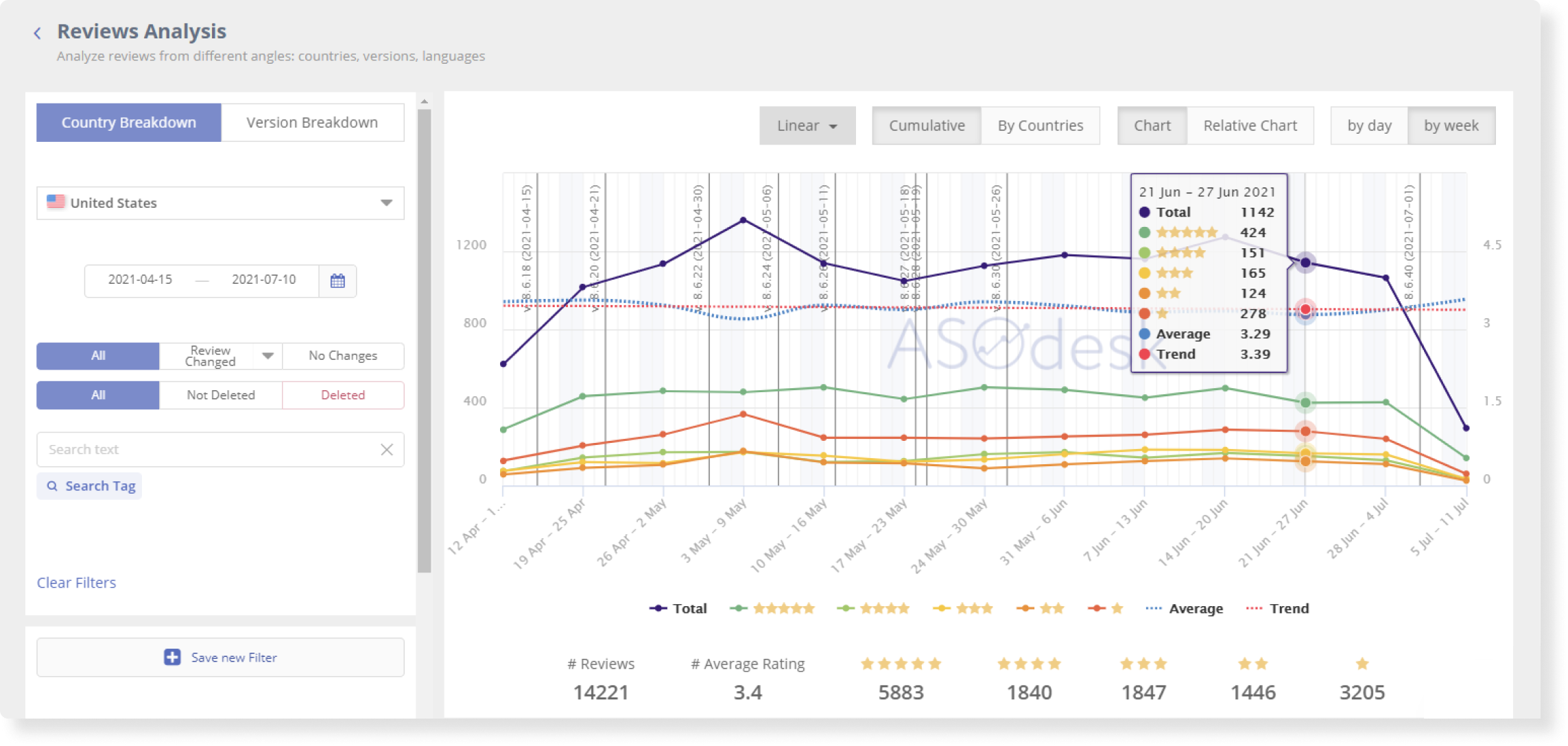
Try to analyze your app’s reviews using this tool.

A developer can also file a complaint about inappropriate reviews in the App Store and Google Play.
To remove a review in the App Store you need to:
1. Select the “Report a Concern” option next to the comment, or write an email to Apple via iTunes Connect: Contact Us > App Store Questions > Customer Reviews > Specific Removal Request. If your claim is justified, the review will be removed.
2. Describe the problem in detail, provide the facts of the wrongfulness of the review. This check will be carried out by an App Store employee and they will require evidence to support your case. It’s also better to translate foreign reviews into English.
3. If support does not respond to your request, you can click the “Report a Concern” button on all necessary reviews.
You can report reviews on the App Store if they contain offensive material, spam, or other content that violates Apple’s Terms and Conditions.
To remove a review on Google Play you need to:
1. Open the Play Console and go to Reviews (Quality > Ratings & Reviews > Reviews).
2. Click the checkbox next to the review you want to report.
3. Select “Report”. If a review does not comply with the publishing rules, Google will remove it.
You can also report reviews on the App Store and Google Play using the Report a Concern feature in Asodesk. To do this, select the desired review in the Replies & Reviews Board and click Report. Your request will be automatically sent to the moderators of the App Store and Google Play.

4. Not using keywords in Google Play reviews
Reviews and responses to them are indexed in Google Play and may slightly affect the position of the application. Therefore, it is important to include keywords in responses to reviews, otherwise, you may lose some traffic.
Use this tool on Google Play to:
- Strengthen your ranking for keywords that you have already used in the metadata.
- Get positions in search for keywords that you did not use in the metadata because of spam or character limit.
- Strengthen the positions of your brand keys.

You can add keywords to the very end of the response or distribute them in the text. It is important that your response does not look like a set of keywords, and that it’s appropriate and clear to the user.
5. Not working with the Helpful/Not helpful feature in reviews
On Google Play and the App Store, you can like or dislike a review. If a review gets a lot of likes, it roses higher in the list of reviews. If it doesn’t get likes, it drops down. With this feature, the developer can directly influence the position of reviews on the app page.
Developers who do not work with this tool miss out on the opportunity to influence the position of reviews on the application page, as well as adjust the featured reviews.
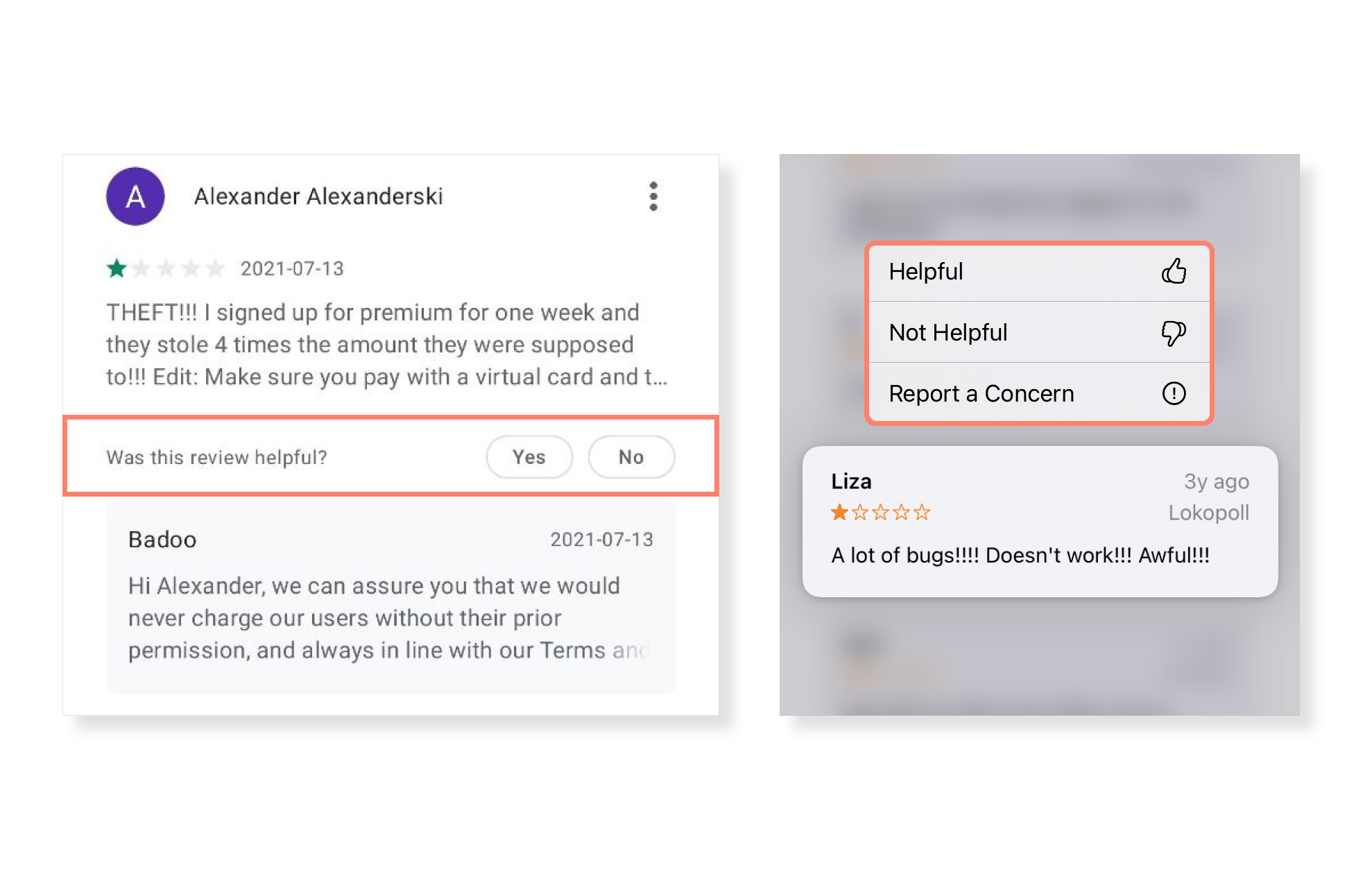
About 30 dislikes will help you keep the featured review out of sight. You also need 30 likes for a positive featured review to rise higher on the app page.
A similar principle may be used for a list of up-to-date reviews; in that case, 15–20 likes or dislikes will be enough for the review to get to the top positions or dropdown.
6. Not having a uniform policy for working with reviews
Many developers don’t write responses to reviews. They also entrust the work on reviews to the technical support or ASO specialists who cannot solve all users’ problems due to their workload or inability.
The lack of a uniform policy for working with reviews leads to the following problems:
1. All responses use a standard template. Of course, you can use templates; it saves a lot of time. However, the choice of template should depend on the specifics of the review. Otherwise, the users will see that you are not trying to solve their problem and are just responding for the sake of it. See examples of standard replies to reviews, which don’t solve users’ problems.

Compare them with 2 great examples of the customized replies to reviews from Zenly.

2. Responses are delayed in time. You need to set rules on the possible time intervals for responding to reviews; otherwise, users might have to wait too long.
3. Attempts to shift conversations with users to email when it is not necessary. If the problem can be solved in the app store, there is no need to ask users to use third-party communication channels: this can be annoying.
5. Lack of a clear management and report system. If the manager does not control the work with reviews, the quality of this work will be inconsistent, and the rating of the application will drop. As a result, it will be difficult to hold employees accountable.
6. Insufficient work with keywords in Google Play. Because of this, you will miss out on additional opportunities to improve your app’s keyword ranking.
7. Lack of systematic work with featured reviews. Users might see negative reviews featured instead of positive reviews.
8. Incorrect information in responses. The manager may give the wrong advice or indicate the wrong deadlines for the implementation of user requests.
9. Disputes with users. Even if the user uses insulting language, the developer should not behave in the same way; this creates a negative brand image. Read how to deal with negative reviews in the article “9 tips for working with reviews”.
To avoid negative results, you need to establish a policy that will include:
1. A set of 5–15 templates for each country, which can be customized for common reviews. In Asodesk, you can create your own templates or use the standard options.

2. Acceptable timeframes for responding to reviews, which take into account days of the week, holidays, and required time for writing the responses.
3. Situations when third-party communication methods such as email and a tech support phone number can be used.
4. The rules for using keywords and phrases in Google Play reviews: how they should be placed in the review, when it is inappropriate to use them, how often new keywords should be selected, and what they should be.
5. A system for monitoring responses to reviews: timeframes for reports and consequences for violating the rules.
6. Regulations for working with featured reviews: how often the reviews should be audited, how the audit results should be recorded and bad reviews processed, whether there will be a system for decreasing and increasing the position of reviews on the page.
In Asodesk, you can analyze featured reviews in all countries where the app is available using the Featured Reviews tool. Create an account and analyze featured reviews for free in Asodesk.

7. Acceptable response formats in case of conflict with the user. It is necessary to establish consequences for violation of the rules and a clear framework for professional communication.
9. Information that the support employee needs to know about the application.
7. Not automating work with reviews
If you analyze and respond to reviews manually, employees will spend more time and the work done will be less effective. This is especially true for applications with a large number of users around the world.
These 3 tips will help you automate work with reviews:
1. Create automatic replies. Instead of responding to every review, you can create rules to send automatic replies. Asodesk chooses an appropriate automatic response depending on the rating, content, and other parameters of the review. Respond with a selected reply, a random reply, or report the review (Concern).
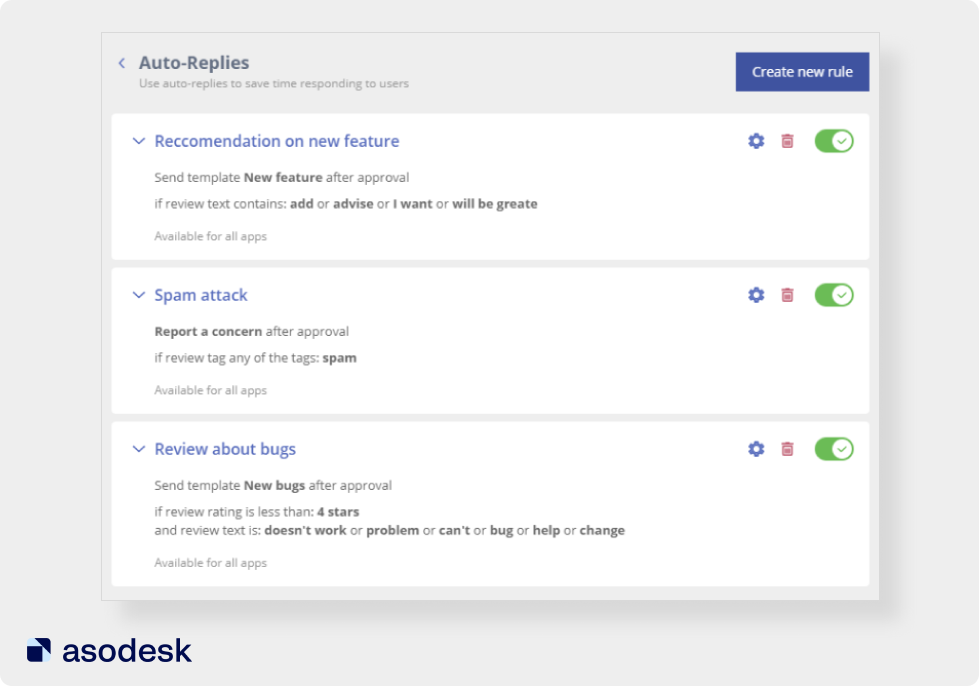
2. Add tags to reviews. They help you analyze your reviews faster. Thanks to tags, you do not have to save every user request. It is sufficient to mark the review with the necessary tag, for example: “bugs after the update”. In Asodesk, you can select tags manually or automate this process using Auto-tags. This feature allows you to create rules for tagging reviews.

3. Analyze the rating and reviews of the application using graphs, tables, and reports. In Asodesk, you can set up automatic email or Slack reports about new reviews. You can also view statistics for any period by the number of reviews, the rating for each version of the application, and the average rating in the country using Ratings Analysis.
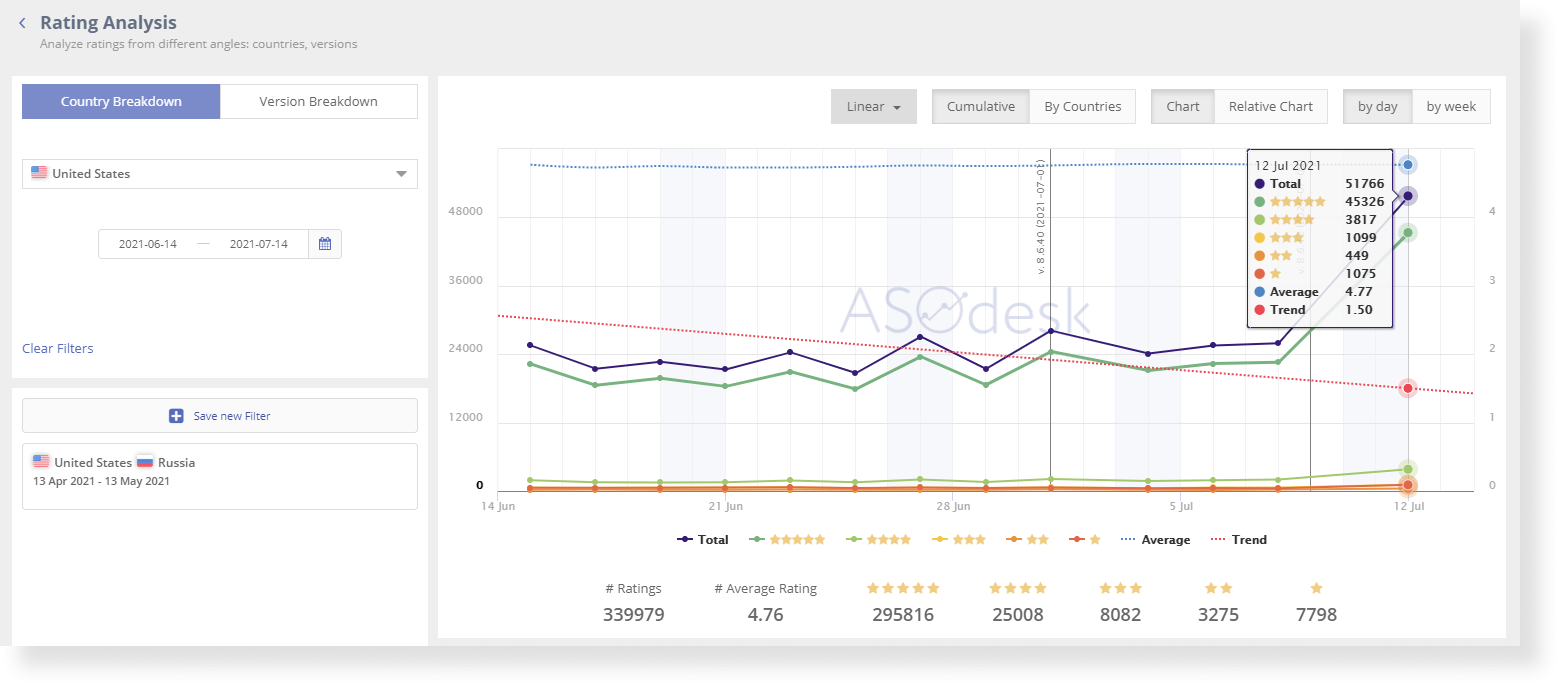

These are just some of the options for working with reviews in Asodesk. Learn more about all available tools here.
7 tips for effective work with reviews
We already told you what mistakes you shouldn’t make. So what should you do? Here are some tips on working with reviews correctly:
1. Motivate users to leave reviews using promotions, push notifications, and bonuses. But do not overdo it; you should only ask for a review when it is appropriate and when you think the user finds your application useful.
2. Do not miss the deadlines for implementing user requests and suggestions. Be honest and don’t make promises you can’t keep.
3. Report inappropriate, offensive, or fake reviews. When reporting these reviews, indicate which section of the app store rules they violate.
4. Use keywords when responding to reviews in Google Play. This will help attract additional traffic, improve the position of your application in the search results, and increase the number of keywords for which you are indexed. Use all tools that app stores have available.
5. Use the Helpful/Not helpful feature. Think about how you can organize work with this feature. For example, change the positions of featured reviews.
6. Develop a policy for dealing with reviews for your employees. A specialist who works with reviews must follow clear rules and instructions. This document will help structure and streamline your work, as well as set tasks and targets that are clear to all specialists and managers.
7. Use tools to automate your work. They will help you analyze reviews and respond to them faster and more efficiently, which will help your app’s ranking grow.










